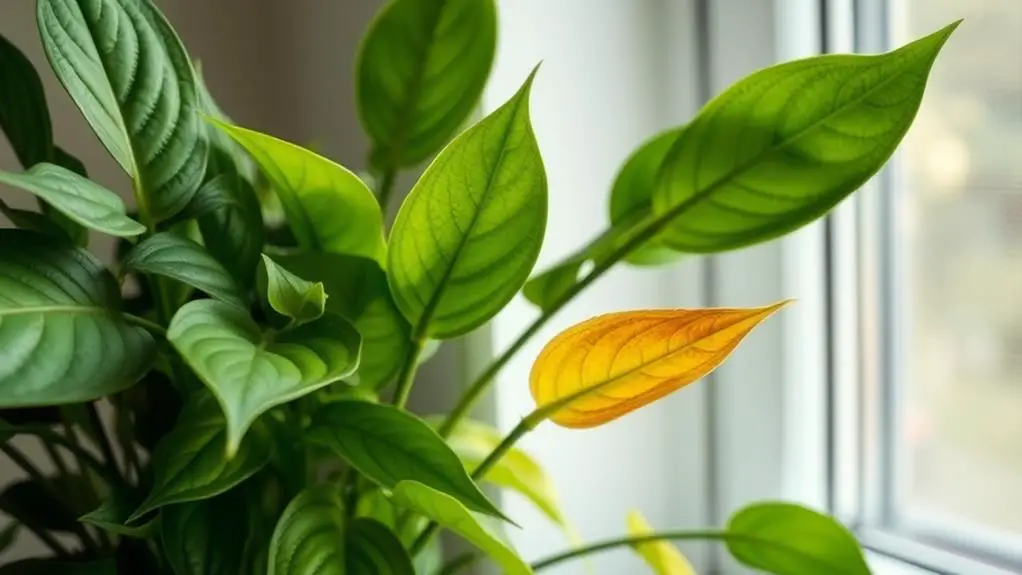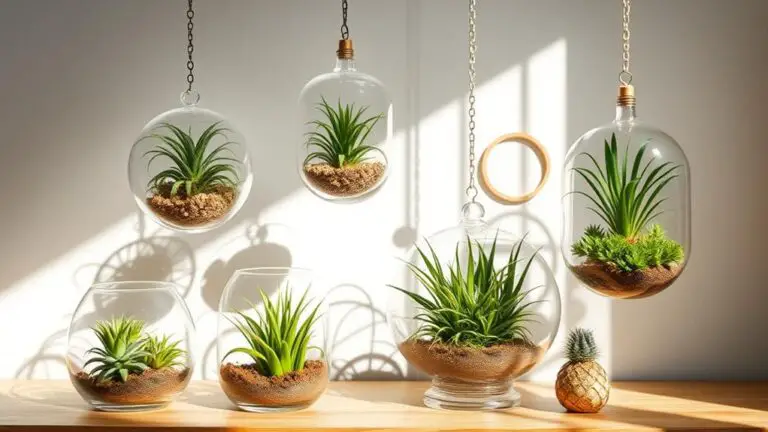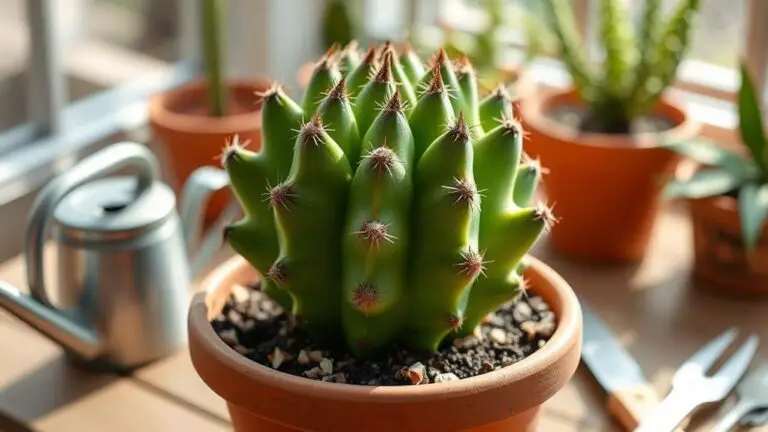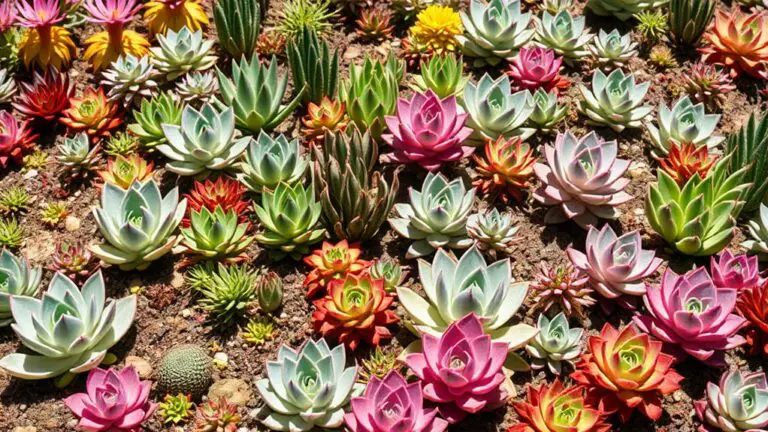Why Do My Houseplant Leaves Turn Yellow?
You might notice your houseplant leaves turning yellow and wonder why that's happening. It's not just one simple answer; several factors could be at play. Overwatering suffocates roots, while underwatering starves them. Nutrient deficiencies disrupt healthy growth, and inadequate light or sudden temperature changes cause environmental stress. Pests feeding on your plant's sap can also result in yellow leaves, and sometimes, it's just a natural aging process. Curious about how to address these issues and keep your plants thriving? Let's explore each potential cause and find solutions that work for you.
Overwatering Issues
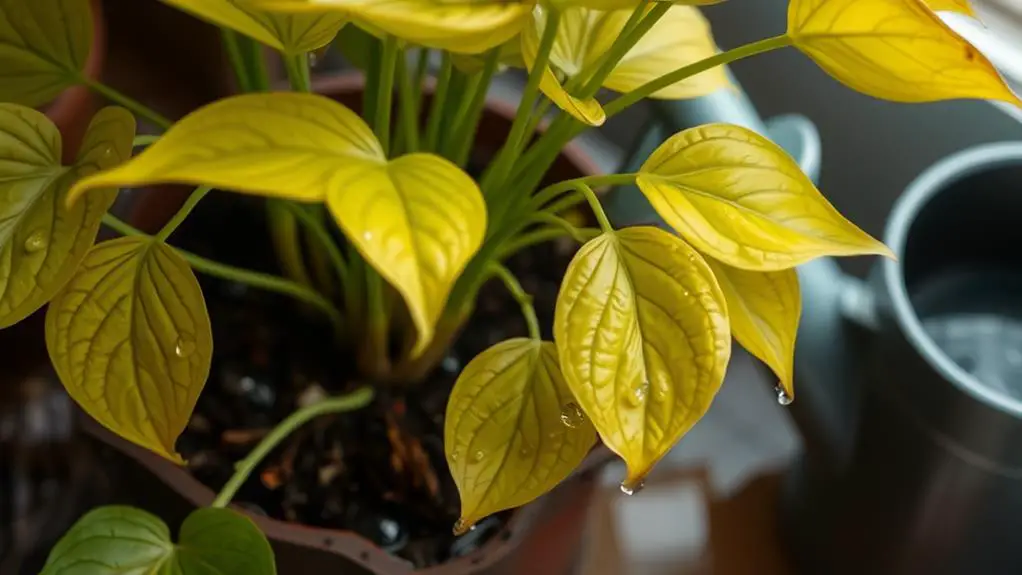
Overwatering is often the primary cause of yellowing leaves in houseplants, leading to root suffocation and nutrient delivery failure. When you overwater, excess moisture in the soil can suffocate the roots, causing them to rot. This root damage prevents the plant from absorbing nutrients properly, which results in yellow leaves.
Typically, you'll notice the lower and inner leaves turning yellow first, and sometimes the stems may appear mushy.
To prevent overwatering, guarantee your pots have adequate drainage holes. These holes allow excess water to escape, preventing it from sitting at the bottom and causing issues.
Also, avoid letting water accumulate in saucers under the pots. A simple weight test can help you determine soil moisture. If the pot feels heavy, the soil is likely wet; if it's lighter, it may need watering.
Regularly checking soil moisture with your finger can also help. Stick your finger about an inch into the soil. If it feels dry, it's time to water.
Underwatering Problems
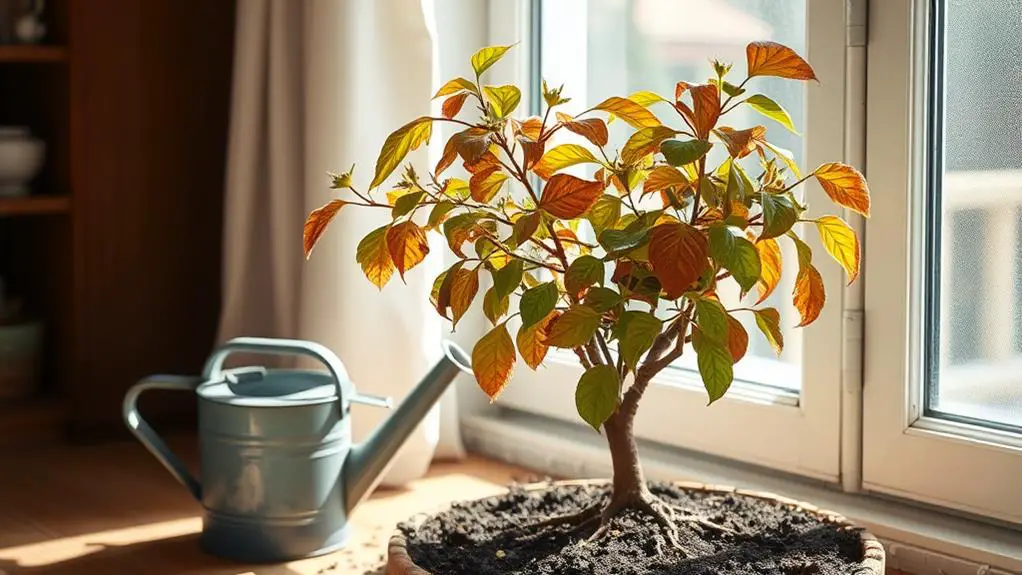
While too much water can be a problem, not giving your houseplants enough water can also lead to yellowing leaves. When your plants don't get enough water, their leaves often turn yellow, starting from the tips and edges. This happens because the plant struggles to absorb enough moisture for nutrient uptake.
You can spot underwatering by checking if the soil is dry and pulling away from the edges of the pot. Leaves may curl inward or develop brown edges too.
To prevent this, you should regularly check the soil moisture using the finger test. Simply stick your finger into the soil; it should feel slightly moist but not soggy before you water again.
Consistent watering practices are essential. Establish a watering schedule based on your plant's specific needs and the conditions in your home.
When the soil feels dry, give your plants a deep, thorough watering. This lets the roots absorb water effectively and prevents yellow leaves from moisture stress.
Poor Soil Drainage
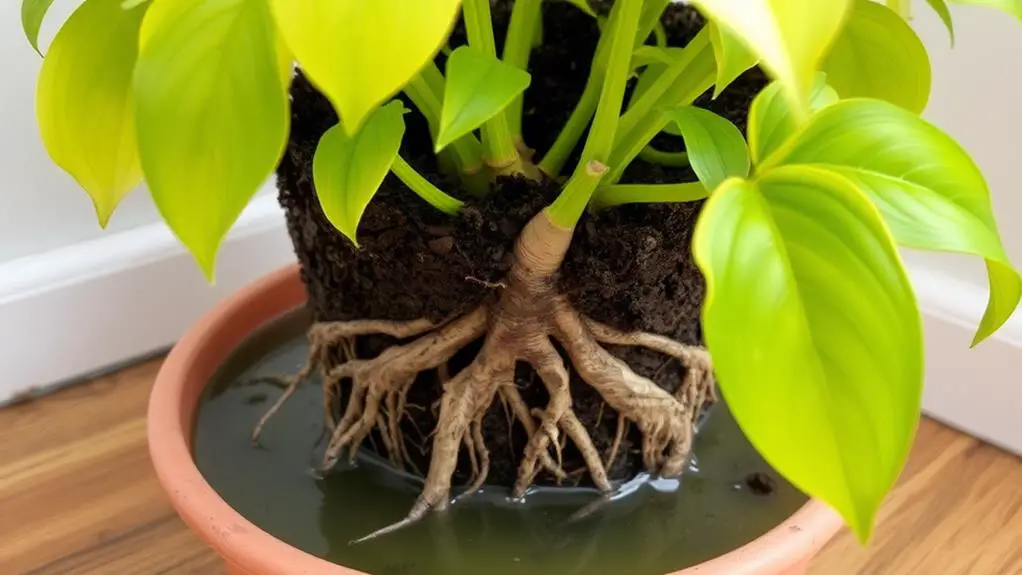
At times, poor soil drainage can be just as detrimental to your houseplants as underwatering. When soil doesn't drain well, it can lead to waterlogged conditions that suffocate roots and prevent them from absorbing essential nutrients. This often results in yellow leaves, a clear sign that your plant is stressed.
To improve soil drainage and keep your plants healthy, follow these steps:
- Use a pot with drainage holes: This allows excess water to escape, preventing root rot and overwatering.
- Choose a high-quality potting mix: A good potting mix promotes better aeration and drainage, guaranteeing your plant's roots can breathe.
- Empty saucers regularly: Excess water pooling in saucers can worsen drainage issues. Make sure to empty these after watering to avoid root rot.
- Incorporate gypsum: If your soil is compacted, adding gypsum can help break it up, improving the movement of water, oxygen, and nutrients.
Regularly check soil moisture levels using the finger test. Stick your finger about an inch into the soil; if it's still moist, you don't need to water.
This simple step helps you avoid overwatering and guarantees your plants have ideal drainage. By addressing poor soil drainage, you can keep those yellow leaves at bay and enjoy thriving houseplants.
Root Damage

Root damage is a common cause of yellowing leaves in houseplants, often resulting from poor watering practices or physical mishandling. When you overwater your plants, it can lead to root rot. Healthy roots should be whitish-yellow, but if they appear dark, that's a sign of rot, which prevents your plant from absorbing nutrients, causing yellow leaves and nutrient deficiency.
Compacted soil is another culprit. It restricts the movement of water, oxygen, and nutrients, leading to root damage and yellowing foliage. To help your plants, make certain the soil is loose enough for roots to breathe. You can incorporate gypsum into compacted clay soils to improve drainage and aeration.
Sometimes, handling your plants during maintenance can unintentionally damage the roots. Using tools carefully and avoiding rough handling can prevent this. If you notice unhealthy or mushy roots during repotting, prune them to encourage healthier growth. However, be gentle; too much damage can prevent roots from recovering.
Keeping an eye on your watering habits and soil condition can help your plants stay healthy and vibrant. By addressing root damage, you'll guarantee your houseplants remain lush and green.
Soil Ph Imbalance
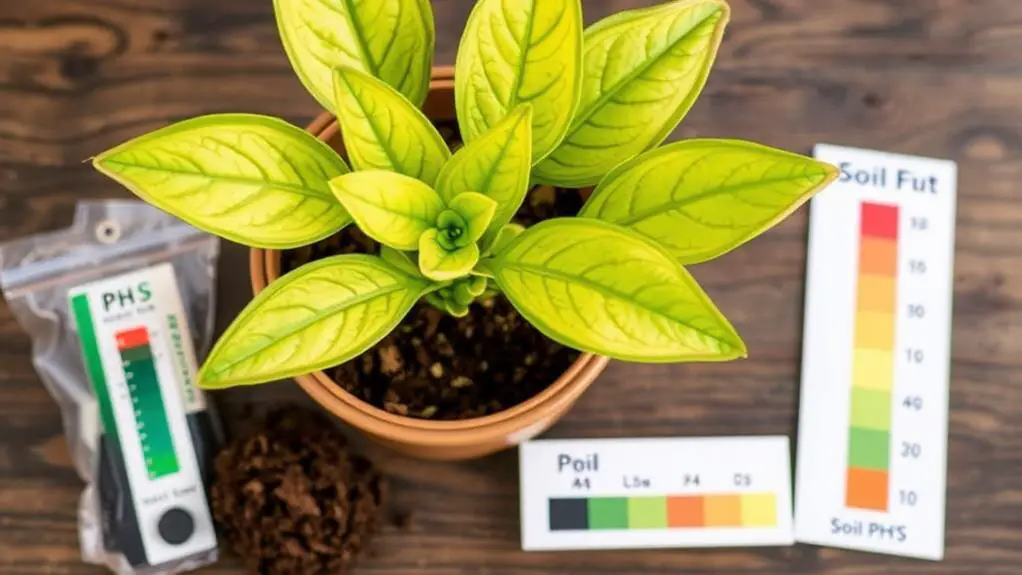
Soil pH imbalance can be a silent culprit behind yellowing leaves in your houseplants. When the soil pH is out of the ideal range (6.0 to 7.0 for most plants), it can disrupt nutrient availability. This means your plant might struggle to absorb essential nutrients, leading to yellowing leaves.
Acid-loving plants need slightly more acidic conditions, between pH 4.5 and 6.0. If the soil becomes too alkaline, it can cause nutrient deficiencies.
To manage soil pH and keep your plants healthy, follow these steps:
- Conduct regular soil testing: It's important to monitor pH levels. You can get a simple soil testing kit from a garden center.
- Identify the issue: If the test shows a pH imbalance, determine if it's too acidic or too alkaline.
- Amend the soil: Use lime to raise the pH (reduce acidity) or sulfur to lower the pH (increase acidity) based on your test results.
- Re-test and adjust: After amending, test the soil again to verify the pH is within the ideal range.
Nutrient Deficiencies
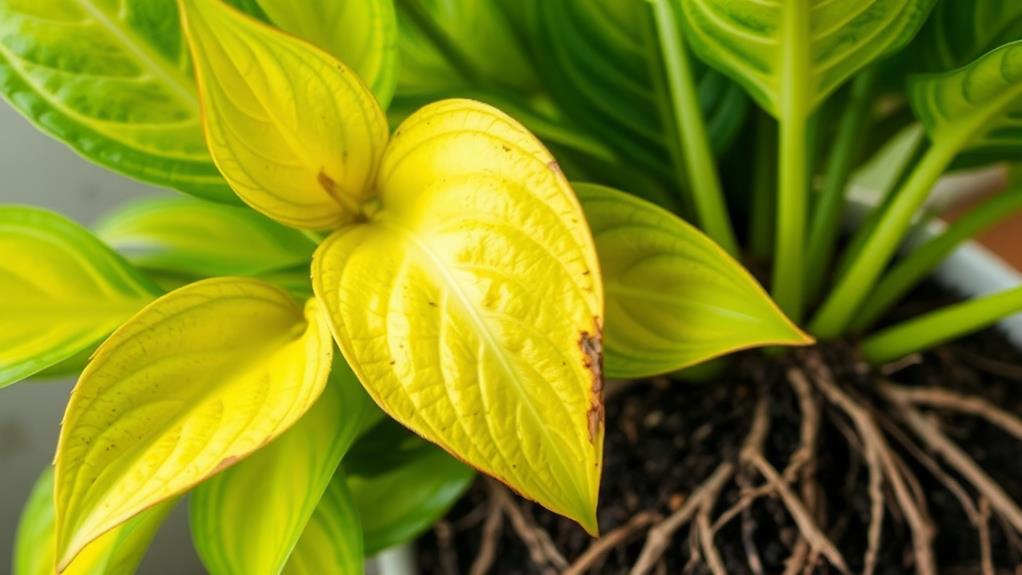
Nutrient deficiencies can be a major reason why your houseplant leaves are turning yellow.
If you see general yellowing starting from older leaves, it might be a nitrogen issue, while bright yellow edges on older leaves could mean a lack of potassium.
Regular soil testing and using balanced plant foods during the growing season can help you pinpoint and fix these problems, ensuring your plants stay healthy and green.
Common Nutrient Deficiencies
Amid the lush greenery of your houseplants, yellowing leaves can be a distressing sight, often signaling common nutrient deficiencies.
It's important to recognize which nutrients your plants might be lacking to take swift action. Here are four common nutrient deficiencies that could be affecting your houseplants:
- Nitrogen deficiency: This causes yellowing of older leaves. Nitrogen is vital for overall plant growth and maintaining vibrant foliage color.
- Potassium deficiency: Look for bright yellow edges on older leaves. Potassium helps with water regulation and photosynthesis, so its absence can really impact your plant's health.
- Magnesium deficiency: This leads to yellow patches between leaf veins, creating a mottled appearance. Magnesium is essential for photosynthesis, and its deficiency can reduce the plant's energy production.
- Iron deficiency: This affects younger leaves, causing yellowing between the veins. High soil pH or poor drainage can prevent iron uptake, leading to this condition.
Understanding these nutrient deficiencies helps you provide the right care for your plants.
Regular soil testing can pinpoint what's missing, guiding you to the correct fertilization. This guarantees your plants get the essential nutrients they need for healthy growth.
Keep an eye on your plants and adjust their care as needed.
Identifying Specific Symptoms
While it's important to know which nutrients might be missing in your houseplants, recognizing the specific symptoms of these deficiencies is equally essential. When leaves turn yellow, it can be a sign of various nutrient issues. By identifying these symptoms accurately, you can take the right steps to restore your plant's health.
For instance, nitrogen deficiency usually causes general yellowing of leaves, starting with the older leaves at the bottom. If the yellowing appears as bright edges on older leaves, with browning tips and margins, it's likely due to a potassium deficiency. Magnesium deficiency, on the other hand, shows as yellow patches between the veins of older leaves while the veins stay green. Iron deficiency affects young leaves first, leading to yellowing between the veins, creating a mottled look.
Regular soil testing can help pinpoint these nutrient deficiencies, allowing you to fertilize your plant appropriately. Here's a quick reference table to help you identify the symptoms:
| Deficiency | Symptom Description |
|---|---|
| Nitrogen | General yellowing, starting with older leaves |
| Potassium | Bright yellow edges on older leaves, browning tips/margins |
| Magnesium | Yellow patches between veins on older leaves, green veins |
| Iron | Yellowing between veins on young leaves, mottled appearance |
Effective Fertilization Strategies
Addressing nutrient deficiencies with effective fertilization strategies is essential for maintaining the vibrant health of your houseplants. Yellowing leaves often signal a lack of nutrients like nitrogen, potassium, or magnesium. To keep your plants lush and green, follow these steps:
- Regular Fertilization: Use a balanced plant food during the growing season. This helps prevent deficiencies that cause yellowing leaves. Make sure to follow the instructions on the packaging for the best results.
- Soil Testing: Get a soil testing kit to check for specific nutrient deficiencies. This helps you target your fertilization efforts precisely, ensuring your plants get exactly what they need.
- Compost: Adding compost to your soil enriches it and provides a slow release of essential nutrients. Compost not only helps with nutrient deficiencies but also improves the overall health of your soil.
- Monitor Soil pH: Keep an eye on your soil's pH levels. If the pH is too high or too low, your plants can't absorb nutrients properly, leading to deficiencies. Kits are available to help you test and adjust soil pH as needed.
Light Exposure
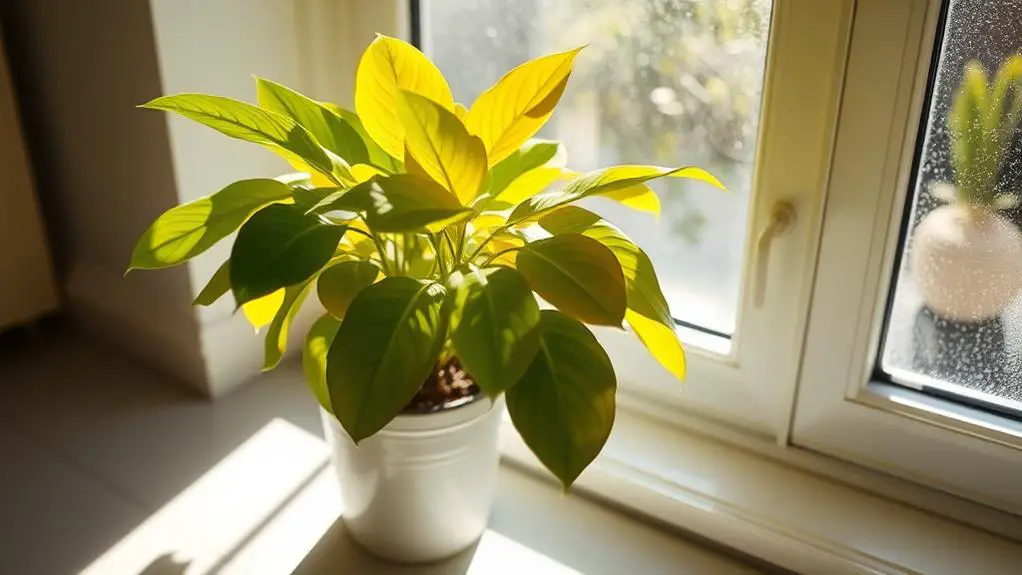
Proper light exposure is crucial for maintaining the vibrant green leaves of your houseplants. When your plants don't get enough light, the lower leaves often turn yellow first. This happens because they aren't receiving adequate sunlight for photosynthesis. It's essential to place your plants in areas where they get the right amount of light.
If your houseplants aren't getting enough light, consider using LED grow lights. These can be particularly helpful during shorter winter days when natural light is limited.
On the other hand, too much light exposure can harm your plants. Excessive light can scorch the leaves, causing them to appear bleached or brown, which can be mistaken for yellowing.
To guarantee even light exposure, try rotating your pots weekly. This practice helps prevent one-sided growth and avoids uneven light distribution, which can cause yellow leaves.
Regularly check your plant's placement according to its specific light needs. By doing so, you'll keep your foliage healthy and green.
Pest Infestations
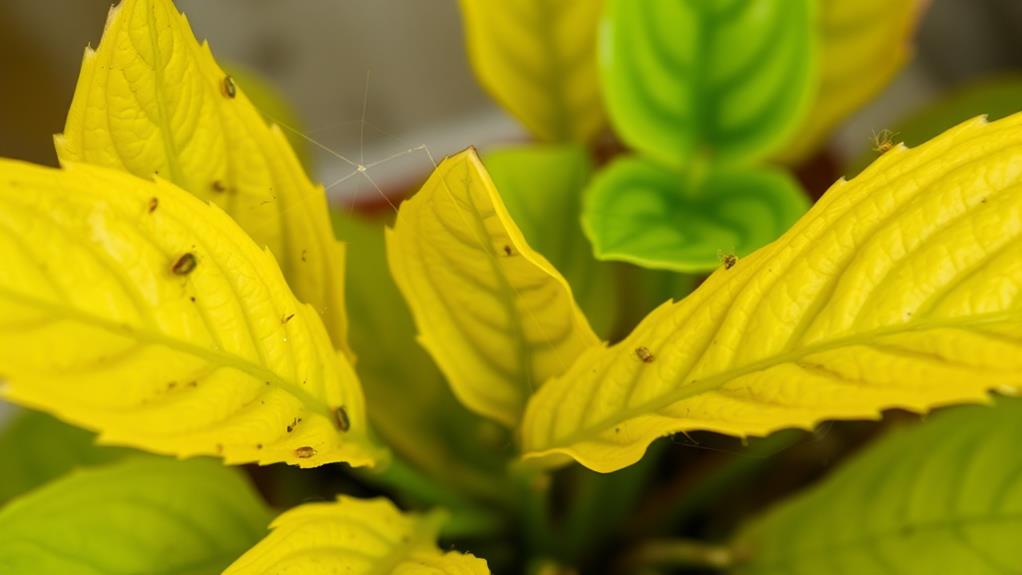
Beyond light exposure, another common culprit behind yellowing leaves is pest infestations. Pests like aphids, spider mites, and scale can sap your plant's energy.
These tiny invaders feed on plant sap, causing leaves to turn yellow. Early signs of pest damage often include yellowing leaves that may also show deformities or stippling from sap extraction.
To keep your plants healthy, regular inspections are essential. Here's how you can manage pest infestations effectively:
- Inspect regularly: Check your plants for pests often to catch any issues before they worsen.
- Use insecticidal soap or neem oil: These treatments can eliminate common pests and help restore your plant's health.
- Maintain cleanliness: Keeping the area around your plants clean can deter pests from settling in.
- Introduce beneficial insects: Ladybugs and other helpful insects can keep pest populations in check.
Environmental Stress
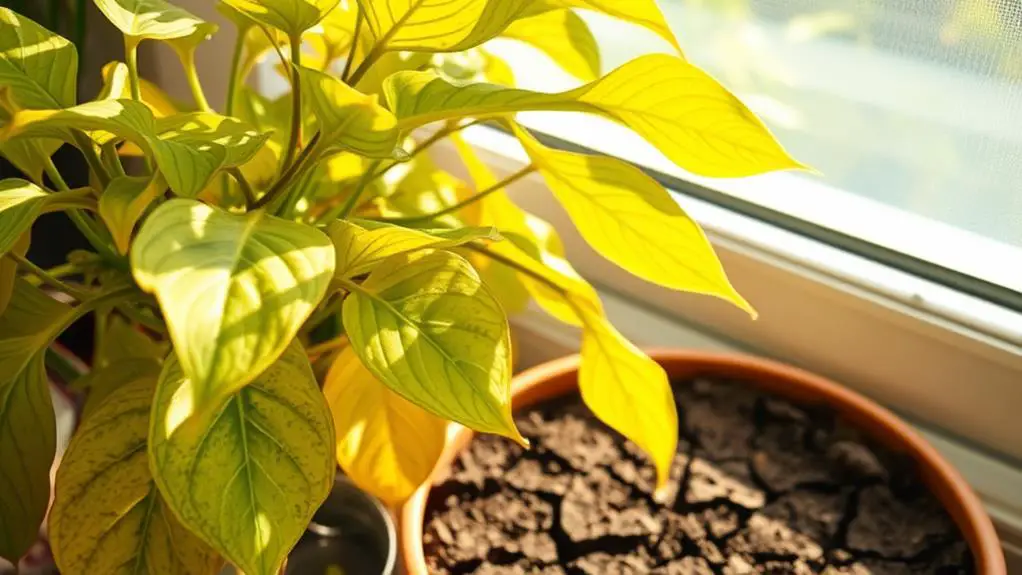
Environmental stress is a major factor that can cause houseplant leaves to turn yellow. When your plant experiences sudden temperature changes, like exposure to cold drafts or extreme heat, it can result in yellowing leaves. To help your plant, keep it away from windows or doors where temperature shifts might occur.
Low humidity levels are another common reason for leaves turning yellow. Many houseplants, especially tropical varieties, thrive in humid conditions. If your home is too dry, consider using a humidifier or placing a tray of water near your plants to increase humidity.
Insufficient light is also a culprit for yellow leaves. If your plant isn't getting enough light, particularly on its lower leaves, they might turn yellow. Make sure your plant receives the right amount of light by placing it near a window or providing artificial light if needed.
Gradual acclimation to new surroundings is vital. Abrupt changes in light intensity or temperature can shock your plant, causing its leaves to yellow. When bringing a new plant home, gradually adjust its environment to help it settle in.
Consistent monitoring and adjustment of environmental factors like humidity and temperature are essential. By doing so, you can prevent stress-related yellowing and keep your houseplants healthy and vibrant.
Normal Aging
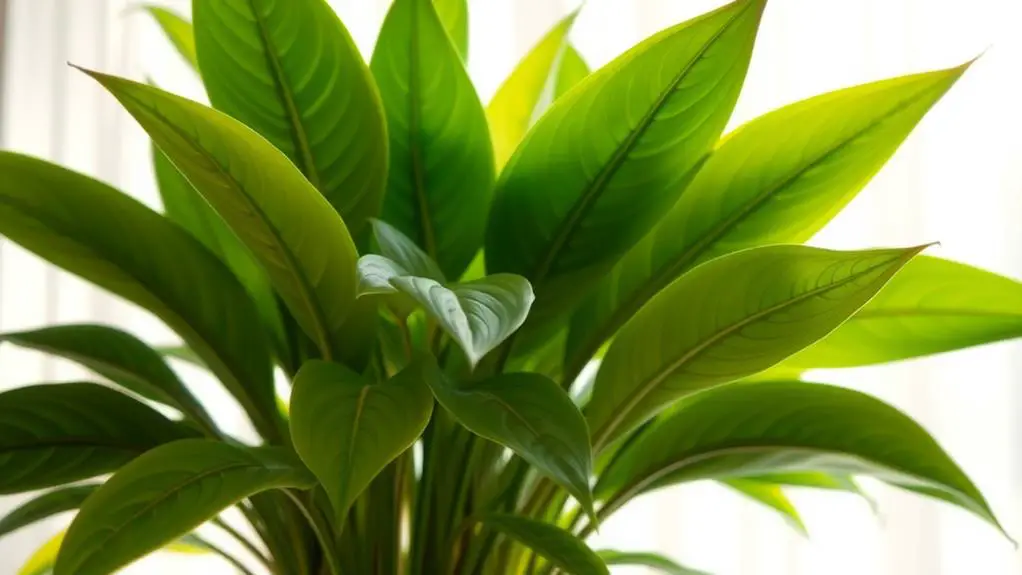
Yellowing leaves can sometimes be simply a sign of your houseplant's normal aging process. As your plant grows, it often redirects nutrients from older leaves to newer ones, causing the older leaves to turn yellow and eventually drop. This nutrient redirect is a natural part of keeping your plant healthy and vibrant.
To help you understand better, here are a few key points:
- Lower Leaves Yellowing: It's common for the bottom leaves of a plant to yellow first. These are the oldest and most expendable leaves.
- Healthy Plant Indicators: A healthy plant will keep producing new leaves despite the natural leaf drop, showing overall liveliness.
- Species Variation: Different plants age at different rates. Some might lose older leaves more often than others.
- Pruning Benefits: Regularly pruning yellowing or dead leaves can encourage bushier growth and improve your plant's appearance.
Don't worry if you see yellow leaves on your plant as long as it's still growing new ones and looking healthy overall. This normal aging process is just part of the plant's lifecycle and a sign that it's thriving.
Frequently Asked Questions
How Do You Fix Yellow Leaves on Plants?
First, check your watering habits, as both overwatering and underwatering can cause yellow leaves. Ascertain good soil drainage and balanced fertilization. Regularly monitor pH levels and inspect for pests or diseases, addressing issues promptly.
What Is a Plant Lacking if the Leaves Turn Yellow?
Your plant's yellow leaves typically indicate a nutrient deficiency. If older leaves turn yellow, it might lack nitrogen or magnesium. Bright yellow edges suggest a potassium deficiency. Yellow young leaves with green veins point to iron deficiency.
Should You Cut Yellow Leaves off Plants?
You should cut yellow leaves off plants. Removing them helps redirect nutrients to healthier parts, prevents disease spread, and improves air circulation. Use clean, sharp scissors or pruning shears for the best results and overall plant health.
Can Yellow Leaves Turn Green Again?
Yellow leaves can sometimes turn green again if you quickly fix issues like overwatering or nutrient deficiencies. However, completely yellow leaves usually won't revert. It's best to remove them so your plant can focus on new growth.
Conclusion
Don't worry if your houseplant leaves turn yellow; it's often fixable! Start by checking your watering habits and soil drainage. Make sure your plant gets the right amount of light and isn't too hot or cold. Look out for pests and consider natural aging too. By tweaking these factors, you'll help your plant stay healthy and green. Keep learning and experimenting, and soon you'll be a confident and successful plant parent!

